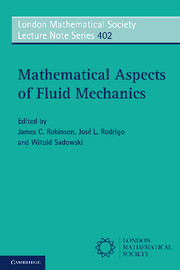Book contents
- Frontmatter
- Contents
- Preface
- List of Contributors
- 1 Towards fluid equations by approximate deconvolution models
- 2 On flows of fluids described by an implicit constitutive equation characterized by a maximal monotone graph
- 3 A continuous model for turbulent energy cascade
- 4 Remarks on complex fluid models
- 5 A naive parametrization for the vortex-sheet problem
- 6 Sharp and almost-sharp fronts for the SQG equation
- 7 Feedback stabilization for the Navier–Stokes equations: theory and calculations
- 8 Interacting vortex pairs in inviscid and viscous planar flows
- 9 Stretching and folding diagnostics in solutions three-dimensional Euler and Navier–Stokes equations
- 10 Exploring symmetry plane conditions in numerical Euler solutions
- 11 On the decay of solutions of the Navier–Stokes system with potential forces
- 12 Leray–Hopf solutions to Navier–Stokes equations with weakly converging initial data
- References
4 - Remarks on complex fluid models
Published online by Cambridge University Press: 05 November 2012
- Frontmatter
- Contents
- Preface
- List of Contributors
- 1 Towards fluid equations by approximate deconvolution models
- 2 On flows of fluids described by an implicit constitutive equation characterized by a maximal monotone graph
- 3 A continuous model for turbulent energy cascade
- 4 Remarks on complex fluid models
- 5 A naive parametrization for the vortex-sheet problem
- 6 Sharp and almost-sharp fronts for the SQG equation
- 7 Feedback stabilization for the Navier–Stokes equations: theory and calculations
- 8 Interacting vortex pairs in inviscid and viscous planar flows
- 9 Stretching and folding diagnostics in solutions three-dimensional Euler and Navier–Stokes equations
- 10 Exploring symmetry plane conditions in numerical Euler solutions
- 11 On the decay of solutions of the Navier–Stokes system with potential forces
- 12 Leray–Hopf solutions to Navier–Stokes equations with weakly converging initial data
- References
Summary
Abstract We review recent global existence and uniqueness results of solutions for models of complex fluids in ℝd. We describe results concerning the Oldroyd-B and related models.
Introduction
Complex fluids are ubiquitous in nature and manifest a rather large number of different behaviours. There is no single accepted general model for all these, and the presence of a large array of complicated models is an indication of the difficulties encountered at a fundamental level. In this article I will describe some of the mathematical issues. A complex fluid is a mixture between a solvent, which is treated as a normal fluid, and particulate matter in it. The particles are sufficiently many and sufficiently small compared to the characteristic scales of the motions of the solvent, so that one may hope for a description that does not have to resolve the fluid mechanical problem of flow past the particles. The particles themselves are treated in a simplified manner as objects m ∈ M, where M is a finite-degrees-of-freedom configuration space accounting for the salient features of the particles. For instance M can be a subset of ℝN or a more complicated metric space. Models have been devised to deal with microscopic elastic thread-like objects such as polymers (Doi & Edwards, 1998, Öttinger, 1996). The complicated hydrodynamic interactions are simplified using the separation of scales, replacing the many degrees of freedom due to them by a few representative ones.
- Type
- Chapter
- Information
- Mathematical Aspects of Fluid Mechanics , pp. 70 - 87Publisher: Cambridge University PressPrint publication year: 2012
References
- 9
- Cited by



